Mastering Under the Sink Bathroom Organization
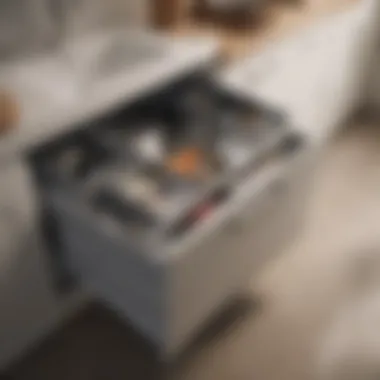
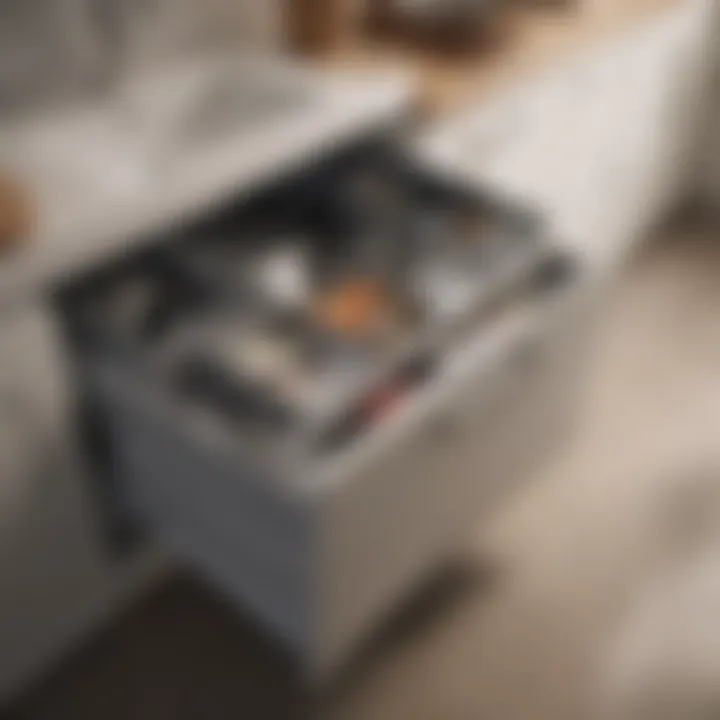
Intro
Organizing the area beneath your bathroom sink has often been an overlooked aspect of home management. The space can easily become cluttered with various products such as cleaning supplies, toiletries, and miscellaneous items. The lack of organization not only decreases functionality but can also create an unpleasent visual result. This guide will navigate the path to effective under-sink organization. With a focus on practicality and aesthetic appeal, homeowners can make the most of this valuable space.
Interior Design Tips
Creating a well-organized under-sink space is as much about functionality as it is about design. Here are several points to consider to transform clutter into an attractive and accessible storage area.
Layout Optimization
The arrangement of items underneath the sink is fundamental. Start by measuring the space available. Knowing the dimensions will guide you in selecting the appropriate storage solutions that fit effortlessly in this often cramped area.
Storage Solutions
When selecting storage, consider using stackable bins and pull-out drawers. These options maximize vertical space and make accessing items easier. Here are some effective storage ideas:
- Tiered storage racks: These allow you to store items on multiple levels, saving space.
- Clear containers: Transparency helps quickly identify contents without rummaging.
- Lazy Susans: Perfect for round spaces, enabling easy access to frequently used products.
Style Considerations
While functionality is key, the look of the storage solutions should not be neglected. Materials with a cohesive color scheme can tie the area together. Opt for muted tones that blend well with your bathroom’s colors. Maintaining a uniform appearance not only enhances the space but also makes it feel more intentional and curated.
"Effective organization elevates the appearance and functionality of your bathroom space, turning a neglected area into an efficient storage solution."
Incorporating design principles into the organization process allows the under-sink area to harmonize with other design elements of the bathroom. Achieving a clean visual will contribute positively to the overall ambiance.
Assessing Your Needs
Before embarking on the organization journey, it's vital to assess what needs to be stored. Consider the types of items typically kept under your sink. Are they different cleaning supplies, personal grooming items, or first aid essentials? Classifying these items by their function simplifies the organization process.
Decluttering Strategy
Decluttering is an essential first step. Here are practical tips:
- Sort items: Begin by grouping similar items together.
- Check expiration dates: Discard any expired products that may clutter the area.
- Donate: If certain items are no longer used, consider giving them away.
This step will not only help clear visible clutter but will also make organizing easier and more effective.
Closure
In summary, organizing under the sink is a multifaceted endeavor that requires determination and strategy. By assessing needs, decluttering intentionally, and implementing smart storage solutions tailored to your design aesthetic, you can transform this overlooked space into a vital and appealing part of your bathroom. Homeowners can achieve both efficiency and style with a little effort and well-planned organization.
Understanding Under Sink Spaces
Organizing the space under the sink is often a neglected area in many bathrooms. This region, though hidden, plays a crucial role in enhancing the overall organization and functionality of the bathroom. Understanding the specific characteristics of under sink spaces is the first step toward effective organization. It involves identifying what items are typically stored beneath the sink and recognizing the challenges presented by this confined area.
The space under the sink often houses cleaning supplies, toiletries, and sometimes plumbing components. The key factors that define this area include its typically restricted height and width, and the presence of pipes and fixtures that may limit storage options.
By organizing this area effectively, homeowners can maximize storage, reduce clutter, and improve accessibility. A well-structured under sink area not only enhances utility but also contributes to a tidier appearance, promoting a sense of order within the bathroom.
Defining the Typical Under Sink Area
The typical under sink area is defined by several elements. Firstly, the dimensions can vary significantly, depending on the type of vanity or cabinet. Standard cabinets may be around 24 to 30 inches wide but can range from 18 to 36 inches in height.
Moreover, the fixtures below the sink, such as pipes and drains, dictate usable space. These elements often present obstacles for storage strategies. Homeowners typically encounter a combination of horizontal and vertical spaces, where careful consideration must be given to how items are stored. It is crucial to take measurements before purchasing storage solutions to ensure a snug fit that maximizes space without hindrance.
Common Issues Encountered
Many face common challenges when it comes to under sink storage. One prevalent issue is inadequate space due to plumbing fixtures.
Additionally, the items stored often become chaotic, leading to frustration when searching for specific products. Items may get buried or shoved to the back, never to be seen until a thorough search commences.
Some common issues include:
- Limited surface area: The presence of plumbing restricts the type and amount of storage that can fit beneath the sink.
- Difficulty in access: Too many items stacked haphazardly can obscure the view, making it tough to reach for regularly used products.
- Moisture damage: The area is typically prone to spills or leaks, putting personal care items at risk of damage.
Understanding these challenges enhances the ability to develop targeted strategies that effectively address each point of concern.
"A functional under sink space can be a game changer in maintaining an organized and efficient bathroom."
By acknowledging the limitations and common pitfalls of the under sink area, one can systematically approach organizing this space in a manner that is not only practical but also adaptable to individual needs.
Assessing Your Needs
Understanding how to effectively organize the space under your bathroom sink begins with a careful assessment of your needs. This step is crucial as it lays the groundwork for a successful organizational strategy. Without a clear grasp of what you currently have and what you actually use, organizing can become overwhelming and impractical. This section will delve into two key aspects: inventorying existing items and distinguishing between essential and non-essential items. Both contribute significantly to enhancing the functionality of your bathroom.
Inventory of Existing Items
Conducting an inventory of your existing items helps create a clear picture of what occupies your under-sink space. Begin by removing everything from the cabinet. This allows you to see the whole area and gives you space to work.
Here are some steps to consider when inventorying:
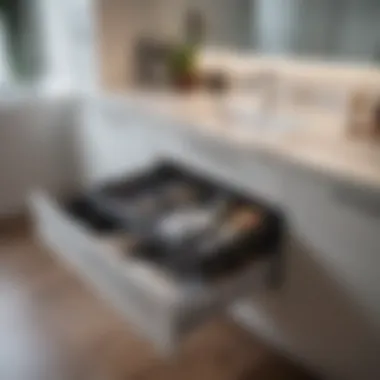
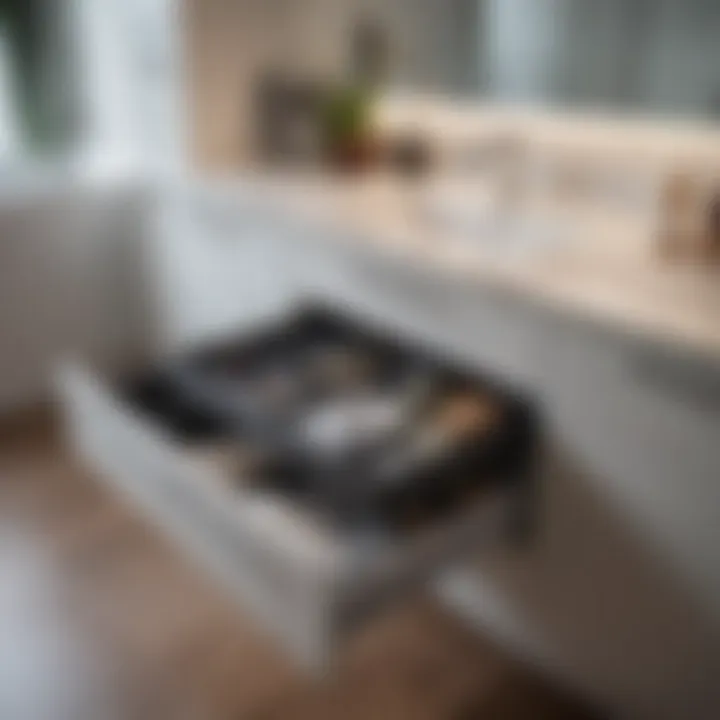
- Catalog each item. You can use a notebook, a spreadsheet, or a simple mobile app to list items. Record product names, quantities, and conditions. This provides an organized baseline to start from.
- Group similar items together. For instance, separate cleaning supplies from personal care products. This categorization aids in understanding what you have and offers insight into the types of storage solutions that will work best.
- Check expiration dates. Items like medicines or beauty products can have finite life spans, so identifying outdated items should be part of the inventory process.
As you complete this process, you will begin to grasp whether your under-sink space serves its purpose or if it requires a new approach to maximize efficiency.
Identifying Essential vs. Non-Essential Items
Once you have a clear inventory, it is time to differentiate between essential and non-essential items. This step is vital in determining what to keep and what can be discarded or relocated.
To aid in this differentiation, consider the following:
- Ask basic questions: Does this item serve a regular purpose? Is it necessary for your daily routine? If the answer is no, it may be time for that item to go.
- Evaluate frequency of use: Items that are used regularly should remain easily accessible. Everything else can be stored away or re-evaluated.
- Consider space: The overall space under the sink is limited. Prioritizing essentials ensures you do not overcrowd this area, which can lead to chaos.
- Balance need and want: Some items may hold sentimental value but lack practical use. Acknowledge their significance yet be mindful of physical constraints.
Ultimately, this phase is about gaining clarity on what truly adds value to your space. By solidifying which items are essential, you’ll have a solid foundation for moving into the next stages of organizing your under-sink area.
"An organized space improves efficiency and reduces stress, both of which are hard to quantify but are keenly felt."
By taking these steps in assessing your needs, you position yourself for a more effective and aesthetically pleasing under-sink organization process.
Decluttering Techniques
Decluttering techniques are vital for creating and maintaining a well-organized under-sink area in the bathroom. The process of decluttering is not merely about removing excess items; it's about fostering a sense of order and boosting efficiency within a limited space. For homeowners who often face challenges with clutter, focusing on these techniques can yield numerous benefits.
Benefits of Decluttering:
- Enhanced Accessibility: Clearing out unnecessary items allows for easier access to frequently used products.
- Improved Space Utilization: A well-organized under-sink cabinet can accommodate more items effectively, maximizing the available space.
- Aesthetic Appeal: An uncluttered area contributes to a cleaner, more pleasing visual appearance, which is particularly beneficial in small and often-crowded bathrooms.
- Reduced Stress: Clutter can induce feelings of anxiety and overwhelm. A tidy environment has been shown to positively impact mental well-being.
Before initiating the decluttering process, it’s critical to consider the existing items and their purposes in order to make informed decisions about what to keep, trash, or donate.
Methods for Effective Decluttering
Effective decluttering requires strategic methods to ensure the process is not just a one-time effort but a foundation for long-lasting order. Here are some methods to streamline the decluttering journey:
- The Four-Box Method:
Prepare four boxes labeled: Keep, Donate, Trash, and Relocate. As you sort items under the sink, place each one in the appropriate box. - Categorization:
Group similar items together, such as cleaning supplies, toiletries, and medical supplies. This will show you what you have in abundance and what may be unnecessary. - Questioning Necessity:
As you evaluate items, ask yourself questions like: "When did I last use this?" Or, "Do I have a better alternative?" This can help motivate decisions. - Storage Solutions:
Consider whether your current storage solutions fit your items well. If not, this may be a signal to declutter.
Adopting these methods can set the tone for a more simplified and systematic declutter.
Timing Your Decluttering Session
Timing plays a crucial role in effective decluttering. Choosing the right moment can significantly influence the quality of your sorting process. The following tips can help assess ideal timing:
- Set Aside Dedicated Time:
Allocate specific times for decluttering sessions. It may help to block time on your calendar so you treat it as an important appointment. - Allow for Short Sessions:
Instead of trying to tackle everything in one go, smaller, focused sessions can be more manageable and less overwhelming. 15 to 30 minutes might be sufficient. - Frequency:
Implement a routine. Regular check-ins, perhaps monthly or seasonally, can help maintain organization and ensure that old items don’t accumulate again. - Choose Times of Low Activity:
Consider decluttering during lower traffic times, such as weekends or evenings, to minimize interruptions and distractions.
Incorporating these timing strategies ensures you approach decluttering with the right mindset and spirit, allowing for a more productive experience.
By systematically utilizing these decluttering techniques, homeowners can create a functional under-sink space that caters to both practical needs and comforts.
Choosing Storage Solutions
Selecting the right storage solutions is crucial for achieving an organized under-sink area. This space, often neglected, can significantly influence the overall functionality of a bathroom. Opting for appropriate storage not only maximizes available space but also enhances the ease of access to everyday essentials. It's about transforming cluttered chaos into orderly convenience. Effective storage setups can also contribute positively to the bathroom’s aesthetics, creating a serene environment.
Evaluating Types of Storage Options
When it comes to under-sink storage, there are various options available. Each type suits different needs, and assessing their benefits is key. Some common storage types include:
- Plastic Bins: Affordable and lightweight, they come in various sizes. You can see contents easily when clear. Some styles offer stackability, which is useful.
- Wire Baskets: These provide good ventilation and are often seen in modern designs. They can help in organizing items that require air circulation, like bathroom towels.
- Drawer Units: Multi-drawer options can streamline the storage process, allowing for separation of small items. Look for ones that fit snugly under the sink.
- Sliding Shelves: These maximize access to back corners, making them practical and efficient.
Each option brings a unique set of advantages and considerations. Think about your specific needs and frequency of item usage to make the best choice.
Assessing Material Durability and Aesthetics
The materials used in storage solutions are vital. Durability will impact how long the products last, especially in a moist environment like a bathroom. Here are some materials to consider:
- Plastic: Resistant to moisture and easy to clean. However, some can miss the mark aesthetically.
- Metal: Provides durability and a modern feel. Ensure that it is rust-resistant to prolong its life under the sink.
- Wood: Offers a classic look. It should be treated against moisture damage for longevity.
When selecting storage, balance durability with style. Matching the storage design to your overall bathroom decor creates coherence. Such careful attention to detail fosters a pleasing environment, which enhances the experience in the bathroom.
"Choosing the correct storage is not just about efficiency; it’s also about creating a welcoming space that reflects personal style."
Utilizing Baskets and Containers
Organizing the space under the sink is crucial for maintaining efficiency and tidiness in the bathroom. One effective strategy is utilizing baskets and containers. These storage solutions not only help to keep items grouped together but also enhance accessibility while optimizing use of space. In a confined area like under the sink, where clutter can accumulate quickly, baskets and containers can serve as a functional yet aesthetically pleasing way to manage various bathroom essentials.
Choosing the Right Containers
Selecting the appropriate containers is a key element in achieving successful organization. Various materials and designs exist, and the right choice depends on several factors: the size of the under-sink area, the types of items being stored, and personal style preferences. Here are a few considerations to keep in mind:
- Size and Shape: Choose containers that fit well in the designated space. Measure the area under your sink to find dimensions that will accommodate your storage solutions without causing overcrowding.
- Material: Containers made of durable materials, such as plastic or metal, are ideal for environments like bathrooms where moisture abounds. Opt for containers that can withstand the occasional spill.
- Functionality: Look for containers with compartments or sections, which can help organize various items more systematically. For example, a caddy may be beneficial for cleaning supplies, while small bins can house personal care products.
Labeling for Easy Access
Once containers are selected, implementing a labeling system can significantly improve the usability of the organized space. Labels not only contribute to an orderly appearance but also provide clarity to all users about where specific items are stored. Here are some tips for effective labeling:
- Clarity: Ensure labels clearly indicate the contents of each container. Use straightforward terms that are easily recognized.
- Placement: Position labels on the front of containers for quick identification. This approach minimizes the time spent searching for specific items when in a hurry.
- Consistency: Keep labeling uniform across all containers. Using the same font and size creates a cohesive look. Consider using waterproof labels, as the bathroom adheres to damp conditions.


Important: A well-organized under-sink area not only saves time but also extends the lifespan of personal care products by preventing damage that can occur when items are haphazardly stored.
In summary, utilizing baskets and containers is an integral part of under-sink bathroom organization. By choosing the right containers and implementing an effective labeling system, maintaining a tidy space becomes significantly more manageable. The benefits are not just aesthetic; they lead to a more functional and efficient bathroom environment.
Maximizing Vertical Space
Maximizing vertical space is crucial for efficient under-sink bathroom organization. With limited room beneath the sink, utilizing vertical elements can transform a cluttered area into a functional storage solution. This not only enhances accessibility but also increases storage capacity without compromising on appearance. The benefits are clear: by organizing vertically, you can see all your items at a glance, thus saving time during busy mornings.
Installing Shelves or Racks
Installing shelves or racks is one of the most effective ways to utilize vertical space. Shelves can accommodate a variety of items from cleaning supplies to extra toiletries, making sure they are off the floor and easily accessible. When considering shelves, opt for adjustable ones. This allows flexibility in space management, accommodating items of varying heights. Moreover, using materials like water-resistant wood or metal can enhance durability, especially in the moist environment of a bathroom.
When selecting the location for your shelves, consider the height that allows easy access without the need for bending or stretching. Secure the shelves firmly to withstand the weight of the items stored.
- Avoid overloading shelves. An organized look requires balance.
- Ensure items on shelves are grouped logically. For example, place cleaning supplies on one shelf and personal care products on another.
Utilizing Hooks and Pegboards
Hooks and pegboards are versatile tools for maximizing vertical storage. They are great for hanging frequently used items such as towels, brushes, or small cleaning devices. Hooks can provide quick access and keep items visible. A pegboard offers the flexibility to rearrange items as needed without any permanent commitment.
When installing hooks or pegboards, consider:
- Material: Select water-resistant or easily cleanable materials to prevent deterioration.
- Placement: Hooks should be near the exit for easy access or within reach of other items.
By integrating hooks and pegboards into your under-sink organization scheme, you create a space that is both functional and visually appealing.
Effective vertical organization can transform chaos into order, making your bathroom a more pleasant space to be in.
Accessibility Considerations
Creating an organized space under the bathroom sink requires careful thought on accessibility. The way you organize this area can significantly affect its usability and efficiency. Accessibility considerations ensure that items are easy to reach, easy to see, and relevant to the user's routine. This section will explore how to group items based on their frequency of use and adapt the organization system for different users, maximizing the functionality of this often-neglected space.
Organizing by Frequency of Use
When organizing products under the sink, it is essential to think about the frequency with which items are used. By prioritizing items, you make it simpler to maintain order and efficiency. High-frequency products should be within easy reach, while those used less often can be stored further back or in less accessible areas. Common items that need daily access might include toothpaste, brushes, or soap. Placing these items at the front helps users find what they need quickly.
To effectively organize by frequency of use, consider the following:
- Daily Essentials: Place items like shampoo, conditioner, and hand soap at the front.
- Occasional Items: Store items such as hair tools behind daily essentials.
- Seasonal or Rarely Used Items: These can go to the back or on shelves if available.
This method not only benefits those who use the bathroom regularly but also assists in minimizing the frustration often caused by cluttered spaces. Efficient organization based on frequency fosters a smoother experience, whether for family members, guests, or even service providers.
Adaptations for Different Users
Not everyone who uses the bathroom is the same, and as such, their needs may vary significantly. Adapting your organizational system to accommodate different users can enhance overall satisfaction and functionality. For instance, households may include individuals of various ages or abilities, and it is important to consider these differences during the organizing process.
Here are some adaptations to think about:
- Height Considerations: For young children, consider placing frequently used items lower. Conversely, for taller individuals, placing items slightly higher can save space and reduce bending.
- Special Needs: For users with mobility issues, consider using bins on sliding shelves or pull-out drawers. This arrangement minimizes the need to bend down or reach awkwardly.
- Personalization: Each user may have their preferences for product arrangement or access. A separate container for each user can help maintain order and respect individual preferences.
These adaptations can create an inclusive environment that caters to everyone’s needs in the household. In the end, an accessible and user-friendly bathroom space enhances satisfaction and aids in maintaining organization over time.
Quote: "Accessibility in organization is not just about ease of access; it fundamentally affects how users interact with their space."
By considering the unique needs of each user, you create an adaptable and efficient under-sink space that serves practical purposes within the bathroom. This ultimately leads to a functionally organized area that everyone can enjoy.
Maintaining Organization
Maintaining organization within the under-sink space is not merely an optional task; it is essential for sustaining functionality and efficiency in one's bathroom. Bouncing back into a cluttered under-sink area can quickly diminish the advantages gained from the initial organization efforts. This section emphasizes the specific elements, benefits, and key considerations that come with consistent maintenance. Without ongoing attention, even the most meticulously arranged spaces can return to chaos.
Regular Check-In Points
Establishing regular check-in points serves as a proactive approach in preventing disorganization. Allocate specific times—perhaps monthly or quarterly—where you reassess what resides under your sink. During these check-ins, consider performing the following tasks:
- Inventory Check: Take note of the items currently stored. Identify any products that are expired or seldom used.
- Clean and Refresh: Use this time to clean the area. Remove dust and spills, ensuring that the environment remains hygienic.
- Reorganize as Needed: Sometimes, the original configuration may no longer suit your current needs. Adjusting your layout can help improve access to frequently used items.
This ongoing dialogue with your storage will prevent clutter from getting out of hand.
Creating a Maintenance Routine
Creating a maintenance routine is a structured approach that anyone can implement. It involves setting specific tasks to complete regularly, which ensures your under-sink storage remains organized. Here are a few suggestions to establish an effective routine:
- Weekly Quick Review: Dedicate a few minutes each week to glance under the sink. Ensure everything is in its designated space and discard any trash.
- Monthly Deep Clean: Set aside time every month for a thorough cleanout. This acts as a deeper check-in, where items can be completely sorted and old products disposed of properly.
- Seasonal Re-evaluation: Every season, think about what you need for the upcoming months. For instance, winter may require different toiletries than summer. Rotate items in and out as necessary to maintain accessibility.
By instituting a methodical approach to maintaining your space, you cultivate habits that ensure organization over time. Ultimately, sustained organization can lead to smoother daily routines and a more pleasant bathroom experience.
"A systematic maintenance process transforms organization from a chore into a seamless part of everyday life."
Engaging in consistent organization strategies keeps your under-sink space efficient and practical, reducing the risk of overwhelming clutter.
Addressing Unique Bathroom Designs
Bathroom designs vary greatly, leading to unique challenges and opportunities for organization. This section focuses on addressing the specifics of under-sink storage based on individual bathroom configurations. Recognizing how to utilize unique designs can improve functionality and aesthetics in your bathroom.
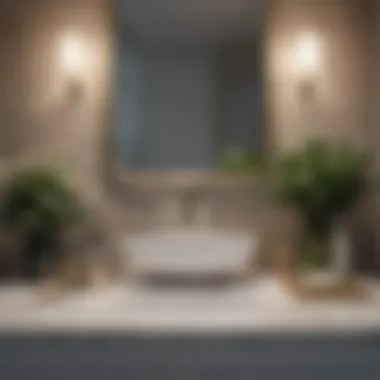
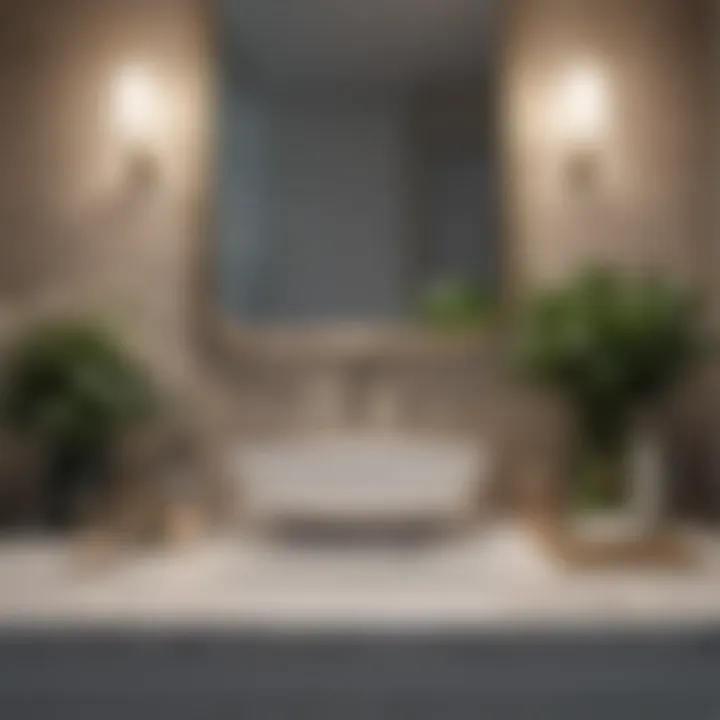
Corner Cabinets
Corner cabinets often offer under-utilized space in a bathroom. These cabinets can be tricky due to their shape, which may not easily accommodate standard storage options. However, with the right approach, you can transform this space into a highly organized area.
- Benefits of Corner Cabinets
These cabinets often provide additional storage capacity. They can house cleaning supplies, toiletries, or towels without impairing the layout of the bathroom. Using lazy susans or tiered organizers can maximize the depth of the corner cabinet. - Considerations:
When organizing a corner cabinet, ensure that you prioritize access to frequently used items. Establish an inner organizational scheme, so all bottles and containers are easy to reach without having to crouch or strain.
Floating Vanities
Floating vanities present a modern design element. Their space-efficient nature can make small bathrooms appear larger, but they also require a tailored approach to under-sink organization. Because of the open space beneath, it may be tempting to leave it empty or cluttered.
- Additional Storage Solutions:
Slatted baskets or open shelving can create an aesthetic appeal while offering functionality. Consider including decorative elements for visual consistency, such as plants or stylish storage bins. - Accessibility:
A key focus should be on keeping essential items like cosmetics or cleaning supplies within reach but neatly contained. Look at container sizes that fit well under the sink without sacrificing space.
"Unique bathroom designs are not just about aesthetics; they directly influence how effectively we can organize and use space."
Ultimately, successfully addressing unique bathroom designs allows homeowners to maximize their under-sink storage. With thoughtful solutions for corner cabinets and floating vanities, it is possible to achieve both sophistication and efficiency.
Eco-Friendly Organization Practices
In the context of under-sink bathroom organization, adopting eco-friendly practices is not only beneficial for the environment but also enhances the overall aesthetic and functionality of the space. With increased awareness of sustainability, homeowners are encouraged to prioritize natural materials and practices that contribute to a healthier home. Eco-friendly organization allows you to minimize your carbon footprint and make more conscious choices about the products and materials you use.
Selecting Sustainable Materials
Choosing sustainable materials for your under-sink organization is paramount. Focus on items made from renewable resources, such as bamboo or recycled plastic. These options are often more durable and can withstand moisture, making them suitable for bathroom use.
- Bamboo Baskets: These are stylish, lightweight, and made from fast-growing plants. They offer a natural look and are often free from harmful chemicals.
- Recycled Plastic Containers: Not only are these containers often lighter than their non-recycled counterparts, but many manufacturers also ensure that their products are free from BPA and other toxins.
- Glass Jars: While heavier, glass is a recyclable material. It can be used for storing various items like cotton balls or makeup brushes. Opting for glass conveys elegance while being eco-friendly.
Using sustainable materials signals a commitment to environmentally responsible practices. Investing in these materials can also save money in the long term, as they typically last longer than cheaper, non-sustainable options.
Recycling and Upcycling Strategies
Implementing recycling and upcycling strategies can significantly enhance the organization of your bathroom while reducing waste. Acknowledging the importance of recycling means thinking about how to extend the life of common household items:
- Repurposing Containers: Instead of discarding old jars or containers, they can be cleaned and repurposed for storage. For example, old glass jars can keep small items neatly organized. This method is not only cost-effective but also adds a unique charm to your organization system.
- Utilizing Cloth Bags: Old fabric or cloth can be sewn into small bags to hold various items. This is an excellent way to reduce waste while creating something functional and pretty.
- Cardboard Boxes: Used old boxes can serve as temporary storage solutions. By decorating or covering them with decorative paper, they can add personal touch while keeping your under-sink area tidy.
Furthermore, many local communities have recycling programs that allow you to dispose of materials responsibly. Making an effort to recycle and repurpose what you already have not only conserves resources but also fosters creativity in your home organization efforts.
By intertwining eco-friendly practices into your organization efforts, you create a bathroom space that is not just neat and aesthetically pleasing, but also aligns with values of sustainability and resourcefulness.
Incorporating Aesthetic Elements
Incorporating aesthetic elements into under-sink bathroom organization is not just about pleasing the eye; it also enhances the overall utility of the space. A well-organized area, which embraces both form and function, contributes to a serene environment that resonates with harmony and style. By paying attention to aesthetics, homeowners can turn a typically utilitarian area into one that reflects personal taste while still serving its practical purpose.
Color Coordination and Design Consistency
Color coordination plays a crucial role in maintaining the visual appeal of the under-sink area. Matching the colors of containers, shelves, and accessories can create a streamlined look. It's advisable to choose colors that complement the bathroom's existing palette. For instance, if the bathroom features pastel tones, using similar hues for organization tools can create a seamless and inviting appearance.
Here are several benefits of a cohesive color scheme:
- Enhanced Visual Flow: A coordinated color scheme leads to a more tranquil environment.
- Simplified Choices: By limiting the color options, the selection process for storage solutions becomes easier.
- Increased Interest: Subtle variations in shade can add depth without chaos.
In terms of design consistency, aligning storage solutions with the overall bathroom aesthetics and style is essential. If the bathroom has sleek, modern components, ensuring that under-sink solutions echo this will maintain a cohesive look throughout.
Textural Variations for Visual Interest
Textural variations also contribute to the aesthetic appeal of an under-sink organization system. Different materials, such as wood, metal, or fabric, can create an engaging contrast that delights the senses. Employing multiple textures adds dimension and character to the space.
When considering textures, reflect on these points:
- Balancing Soft and Hard Materials: Combining soft fabric containers with hard shelving can create a visually appealing balance.
- Creating Contrast: Using different textures can guide the eye and make the area more visually stimulating.
- Functionality with Style: Textured solutions, like woven baskets or metal organizers, not only look good but may also provide unique organizational benefits.
In summary, emphasizing aesthetic elements in under-sink organization enhances its effectiveness and aligns it with the overall bathroom design. Homeowners should consider color coordination and textural variations for a well-rounded and visually appealing approach to space management.
"A well-organized bathroom can significantly boost daily efficiency and reduce stress, so merging functionality with aesthetics is essential."
For more insights on home organization and design, resources such as Britannica and community discussions on Reddit can provide additional inspiration and practical tips.
The Ends on Bathroom Organization
Effective organization under the bathroom sink is paramount for enhancing efficiency and usability. This often neglected space can become a model of functionality when approached with the right strategies. In this section, we encapsulate the main ideas presented earlier, while underscoring the significance of maintaining an organized area beneath the sink.
Organization is not merely about aesthetics. It is about creating a system that allows ease of access. An organized space is essential for quick retrieval of items, reduces time spent searching for products, and minimizes clutter. Moreover, organizing under the sink can help protect items from moisture damage and mold, which are common in bathrooms.
When planning your organization strategy, consider both immediate and long-term needs. Tailoring the storage solutions based on your lifestyle and frequency of use is essential. Remember that organization is an ongoing process rather than a one-time task. Regular check-ins and adjustments ensure that the system remains practical and functional.
"A well-organized space can significantly improve your daily routines."
This approach to under-sink organization is conducive not only to efficiency but also to creating a serene environment. It reflects a mindful approach to home management, where every item has its place, contributing to an overall sense of harmony in your bathroom.
Summary of Key Points
- Prioritize Functionality: The primary goal of organizing is to enhance accessibility and use of space.
- Flexible Solutions: Tailor storage to meet both current and future needs, adapting as circumstances change.
- Regular Maintenance: Schedule periodic reviews of the organized space to preserve its functionality and order.
- Consider Environmental Factors: Moisture control and suitable storage selections play a critical role in maintaining the integrity of stored items.
Final Recommendations
To implement successful organization, consider the following suggestions:
- Invest in Quality Storage Solutions: Choose durable bins and organizers that can withstand damp environments.
- Utilize Vertical Space Effectively: Shelving, hooks, and tiered organizers can maximize storage potential, making items more visible and accessible.
- Keep Essentials at Hand: Regularly used items should be easy to reach, while less frequented products can be stored in harder-to-reach places.
- Label Everything: Clear labeling can facilitate quick identification, which minimizes search time.
- Review and Reassess Periodically: Commit to a yearly review of what is stored under the sink; discard expired products and reorganize as necessary.
By focusing on these principles, you can ensure that the under-sink space is not just organized, but also a seamless part of your bathroom's overall design and functionality.







